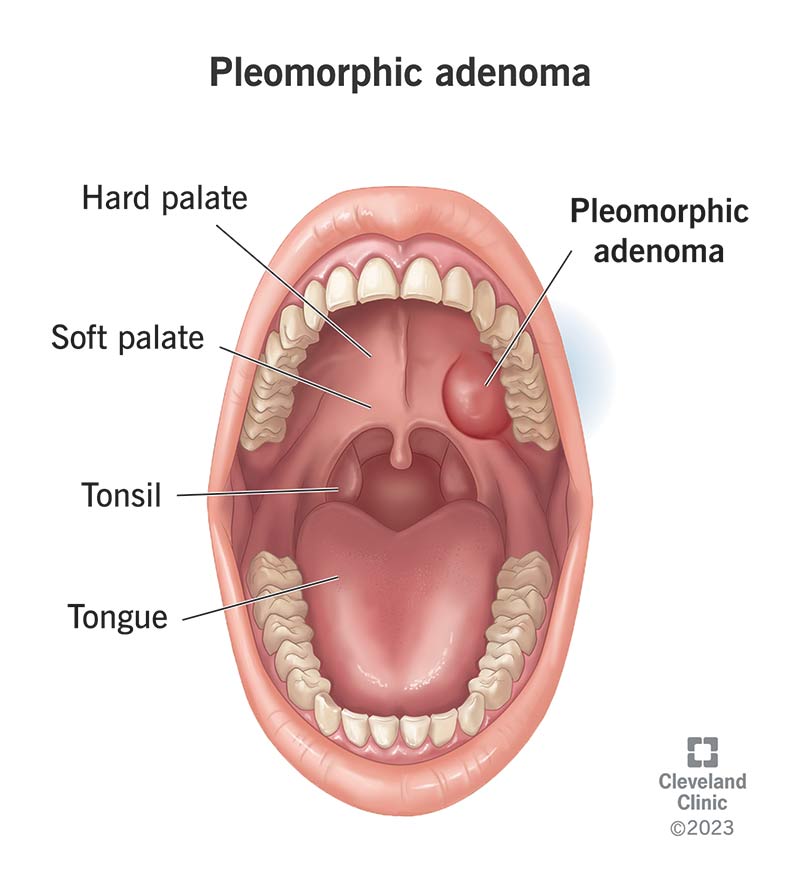Pleomorphic adenomas are rare benign (noncancerous) tumors that can develop on your salivary glands. While these tumors are benign, they can turn into cancerous tumors. For that reason, healthcare providers typically recommend surgery to remove them. Once removed, pleomorphic tumors rarely come back.
Advertisement
Cleveland Clinic is a non-profit academic medical center. Advertising on our site helps support our mission. We do not endorse non-Cleveland Clinic products or services. Policy

A pleomorphic adenoma is a benign (noncancerous) tumor that can affect your salivary glands, particularly your parotid glands. Surgeons treat these tumors by removing all or part of the affected gland. Once removed, pleomorphic adenomas typically don’t come back.
Advertisement
Cleveland Clinic is a non-profit academic medical center. Advertising on our site helps support our mission. We do not endorse non-Cleveland Clinic products or services. Policy
Pleomorphic adenomas are rare. They affect an estimated 3 per 100,000 people in the U.S. However, they’re the most common type of benign salivary gland tumor. Anyone may develop this tumor, but they typically affect women between ages 30 and 70.
Pleomorphic adenoma symptoms may appear:
These tumors grow very slowly, so you may not have symptoms right away. Symptoms include:
Most pleomorphic adenomas measure 2 centimeters (about the size of a peanut) to 6 centimeters (about the size of an egg). Without treatment, however, pleomorphic adenomas may grow to be quite large, measuring as much as 35 centimeters (approximately 13 inches).
Medical researchers don’t know exactly what causes pleomorphic adenomas. They have identified a few potential risk factors:
Advertisement
Around 5% of pleomorphic adenomas turn into cancerous tumors known as carcinoma ex pleomorphic adenomas. Medical researchers don’t know why this happens.
Healthcare providers diagnose pleomorphic adenomas by doing a physical examination and asking about your symptoms. They may order the following tests:
The most common treatment is surgery to remove all or part of the gland affected by a pleomorphic adenoma. For example, a surgeon would treat a pleomorphic adenoma of parotid gland by performing a parotidectomy.
All surgery comes with potential complications, including:
More than 90% of pleomorphic adenomas removed with surgery don’t come back. That means surgery cures the condition.
Medical researchers aren’t sure what causes a pleomorphic adenoma, so there’s no way to prevent one.
The best way to take care of yourself is to keep an eye on new lumps near your jaw or ear. If they don’t go away within a week or so, contact a healthcare provider. You may wonder if it makes sense to contact a healthcare provider about a new lump or bump that doesn’t go away. The short answer is yes, it does make sense. And you’d be in good company. Unusual lumps and bumps are among the most common reasons why people see providers.
While it’s not likely, new lumps near your jaw or ear may be a symptom of pleomorphic adenomas on your parotid or submaximal glands. Pleomorphic adenomas aren’t cancer, but they can turn into cancerous tumors.
If you needed surgery to remove a pleomorphic adenoma, ask your surgeon about any complications from surgery that may require immediate medical care.
You may want to ask the following questions:
Pleomorphic adenomas are benign (noncancerous) tumors that may develop on your salivary glands. They may look like small lumps in front of your ears, under your jaw or inside of your mouth. These tumors grow very slowly, so you can have a pleomorphic adenoma for years before noticing symptoms. Rarely, some tumors become cancerous. Fortunately, surgery to remove the tumors cures the condition.
Advertisement
When you need parotid gland surgery (parotidectomy), Cleveland Clinic can help. Our experts use advanced, precise techniques to protect your facial nerve.

Last reviewed on 06/12/2023.
Learn more about the Health Library and our editorial process.